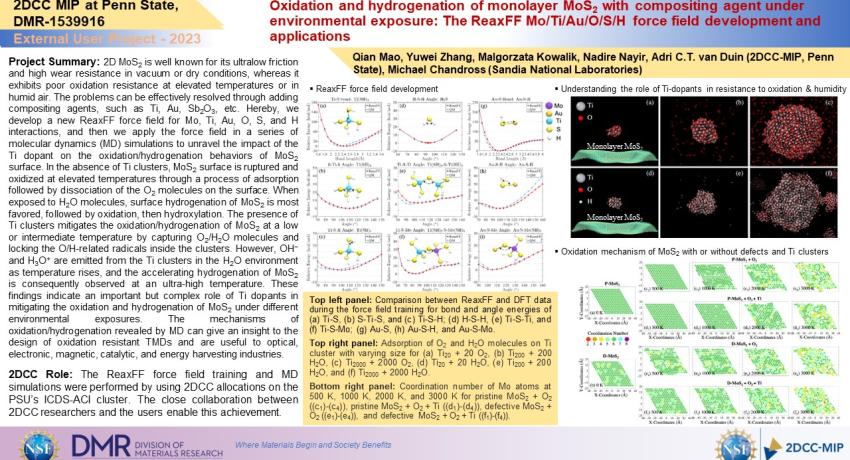Project Summary: 2D MoS2 is well known for its ultralow friction and high wear resistance in vacuum or dry conditions, whereas it exhibits poor oxidation resistance at elevated temperatures or in humid air. The problems can be effectively resolved through adding compositing agents, such as Ti, Au, Sb2O3, etc. Hereby, we develop a new ReaxFF force field for Mo, Ti, Au, O, S, and H interactions, and then we apply the force field in a series of molecular dynamics (MD) simulations to unravel the impact of the Ti dopant on the oxidation/hydrogenation behaviors of MoS2 surface. In the absence of Ti clusters, MoS2 surface is ruptured and oxidized at elevated temperatures through a process of adsorption followed by dissociation of the O2 molecules on the surface. When exposed to H2O molecules, surface hydrogenation of MoS2 is most favored, followed by oxidation, then hydroxylation. The presence of Ti clusters mitigates the oxidation/hydrogenation of MoS2 at a low or intermediate temperature by capturing O2/H2O molecules and locking the O/H-related radicals inside the clusters. However, OH− and H3O+ are emitted from the Ti clusters in the H2O environment as temperature rises, and the accelerating hydrogenation of MoS2 is consequently observed at an ultra-high temperature. These findings indicate an important but complex role of Ti dopants in mitigating the oxidation and hydrogenation of MoS2 under different environmental exposures. The mechanisms of oxidation/hydrogenation revealed by MD can give an insight to the design of oxidation resistant TMDs and are useful to optical, electronic, magnetic, catalytic, and energy harvesting industries.
2DCC Role: The ReaxFF force field training and MD simulations were performed by using 2DCC allocations on the PSU’s ICDS-ACI cluster. The close collaboration between 2DCC researchers and the users enable this achievement.
What Has Been Achieved: In this work, we have developed a new ReaxFF reactive force field for Mo, Ti, Au, O, S, and H (ReaxFF Mo/Ti/Au/O/S/H-2022) to investigate the role of Ti clusters in preventing the oxidation and hydrogenation of a monolayer MoS2 surface in O2- and H2O-rich environments. Our ReaxFF molecular dynamics (MD) simulations reveal the oxidation and hydrogenation mechanisms for the MoS2 surfaces exposed to O2 and H2O environments with and without the presence of Ti clusters.
Importance of the Achievement: The newly developed ReaxFF force field opens an opportunity for understanding the Mo/Ti/Au/O/S/H interactions of MoS2-gas interfaces for the 2D materials modeling society. The subsequent MD simulations uncover the impact of the Ti dopant on the oxidation/hydrogenation behaviors of MoS2 surface. The MD results provide a theoretical basis for engineering the oxidation and anti-oxidation properties of MoS2 thin films and other transition metal dichalcogenides, which can benefit 2D material designs in automotive, aerospace, semiconductor, and nanotechnology industries.
Unique Feature(s) of the MIP that Enabled this Achievement: 2DCC-MIP’s allocations on the PSU’s Institute for Computational and Data Sciences - Advanced Cyber Infrastructure (ICDS-ACI) cluster enable the ReaxFF force field training and the series of MD simulations for this work.
Publication: Qian Mao, Yuwei Zhang, Malgorzata Kowalik, Nadire Nayir, Michael Chandross, Adri C.T. van Duin. Oxidation and Hydrogenation of Monolayer MoS2 with Compositing Agent under Environmental Exposure: The ReaxFF Mo/Ti/Au/O/S/H Force Field Development and Applications. Frontiers in Nanotechnology 4, 1034795 (2022). https://doi.org/10.3389/fnano.2022.1034795.
Acknowledgments: The authors acknowledge the funding from the National Science Foundation 2D Crystal Consortium Materials Innovation Platform (NSF 2DCC-MIP) under cooperative agreement DMR-1539916. Computations for this research were performed on the 2DCC-MIP allocations through PSU’s Institute for Cyber Science Advanced Cyber Infrastructure (ICS-ACI) through 2DCC allocations. This work was funded by the Laboratory Directed Research and Development program at Sandia National Laboratories, a multi-mission laboratory managed and operated by National Technology and Engineering Solutions of Sandia, LLC., a wholly owned subsidiary of Honeywell International, Inc., for the US. Department of Energy’s National Nuclear Security Administration under contract DE-NA0003525. Any subjective views or opinions that might be expressed in the paper do not necessarily represent the views of the US. Department of Energy or the United States Government.
